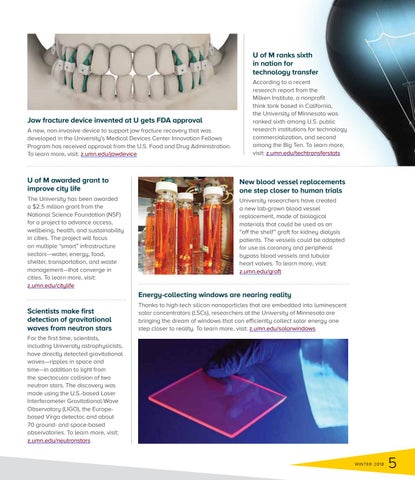U of M ranks sixth in nation for technology transfer
Jaw fracture device invented at U gets FDA approval A new, non-invasive device to support jaw fracture recovery that was developed in the University’s Medical Devices Center Innovation Fellows Program has received approval from the U.S. Food and Drug Administration. To learn more, visit: z.umn.edu/jawdevice
U of M awarded grant to improve city life The University has been awarded a $2.5 million grant from the National Science Foundation (NSF) for a project to advance access, wellbeing, health, and sustainability in cities. The project will focus on multiple “smart” infrastructure sectors—water, energy, food, shelter, transportation, and waste management—that converge in cities. To learn more, visit: z.umn.edu/citylife
Scientists make first detection of gravitational waves from neutron stars
According to a recent research report from the Milken Institute, a nonprofit think tank based in California, the University of Minnesota was ranked sixth among U.S. public research institutions for technology commercialization, and second among the Big Ten. To learn more, visit: z.umn.edu/techtransferstats
New blood vessel replacements one step closer to human trials University researchers have created a new lab-grown blood vessel replacement, made of biological materials that could be used as an “off the shelf” graft for kidney dialysis patients. The vessels could be adapted for use as coronary and peripheral bypass blood vessels and tubular heart valves. To learn more, visit: z.umn.edu/graft
Energy-collecting windows are nearing reality Thanks to high-tech silicon nanoparticles that are embedded into luminescent solar concentrators (LSCs), researchers at the University of Minnesota are bringing the dream of windows that can efficiently collect solar energy one step closer to reality. To learn more, visit: z.umn.edu/solarwindows
For the first time, scientists, including University astrophysicists, have directly detected gravitational waves—ripples in space and time—in addition to light from the spectacular collision of two neutron stars. The discovery was made using the U.S.-based Laser Interferometer Gravitational-Wave Observatory (LIGO), the Europebased Virgo detector, and about 70 ground- and space-based observatories. To learn more, visit: z.umn.edu/neutronstars
W INT E R 2 0 1 8
5
